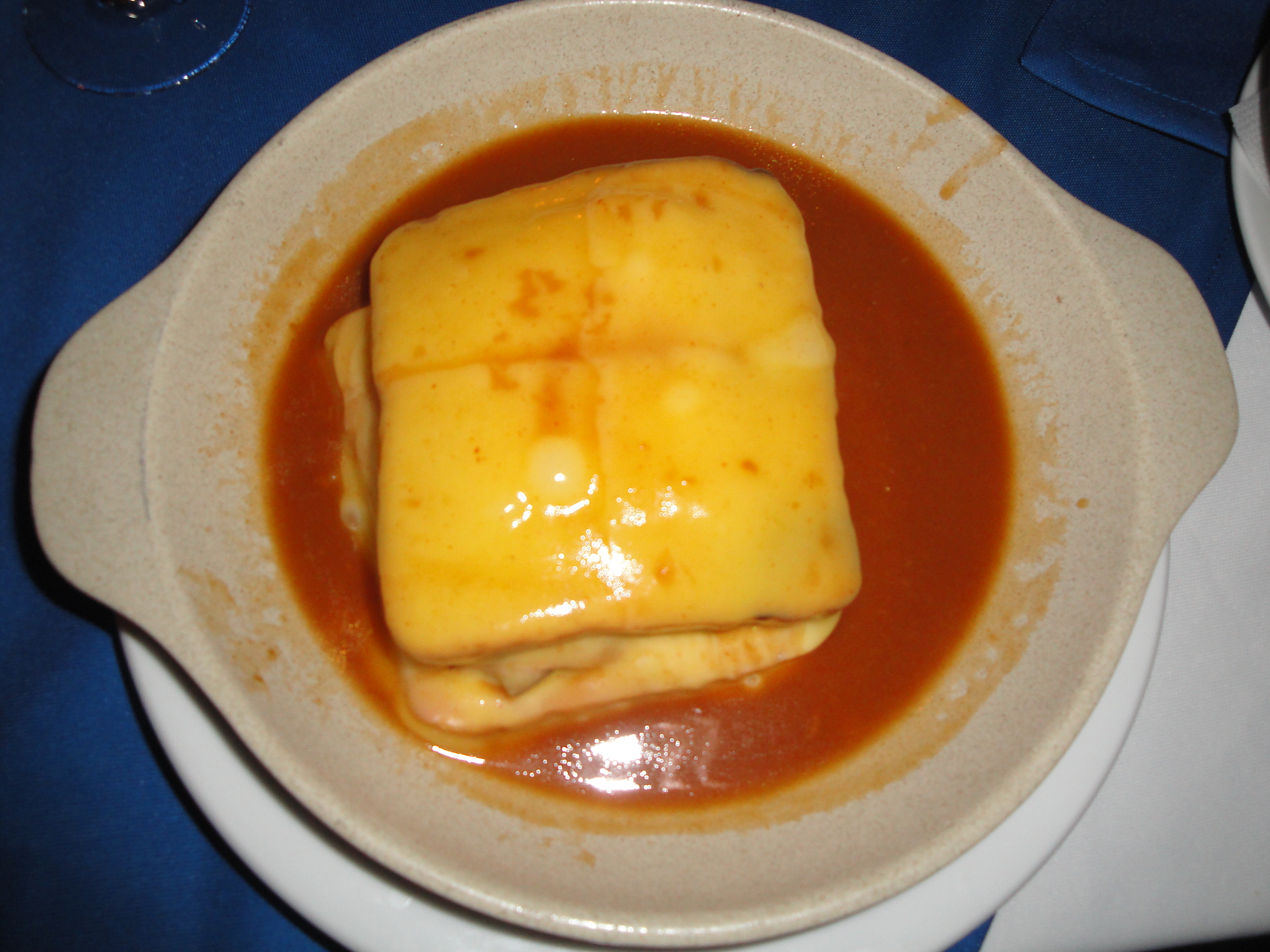
Cozido a Portuguesa is the most popular portuguese food. It contains cabbage, differents kind of chourico, different kind of meat, potatoes, carrots and same people make rice with it. Personaly I don't like with rice. you can find this food in every restaurant in Portugal, especilly in the most old restaurant. It is really good ;)

This dish is named Feijoada. The basic ingredients of Portuguese feijoada are beans and fresh pork or beef. In northwest Portugal (Minho and Douro Litoral), it is usually made with white beans; in the northeast (Trás-os-Montes), it is generally prepared with red beans, and includes other vegetables such as tomatoes, carrots, and cabbage. The stew is best prepared over low heat in a thick clay pot.
Portuguese feijoada is usually served with rice and assorted sausages, such as chourico, morcela, farinheira, which may or may not be cooked in the stew.

Francesinha is a Portuguese sandwich originally from Porto, made with bread, wet-cured ham, linguiça, fresh sausage like chipolata, steak or roast meat and covered with molten cheese and a hot thick tomato and beer sauce served with french fries or just the sandwich, the choice is yours.

Bacalhau à Gomes de Sá is essentially a casserole of cod, potatoes, eggs, olives, olive oil and onion. It is a speciality from the northern city of Porto, being today popular throughout Portugal, and is considered one of Portugal's greatest bacalhau recipes.Gomes de Sá was the son of a rich nineteenth century merchant in Porto. The family fortune dwindled and the son had to find a job at the famous restaurant Restaurante Libonense in downtown Porto. It was there that he created the now well known recipe.

Bacalhau à Brás is one of the most popular ways to prepare codfish in Portugal. It is made from shreds of salted cod, onions and thinly chopped fried potatoes in a bound of scrambled eggs. It is usually garnished with black olives and sprinkled with fresh parsley. It is a very common dish in cafes and restaurants as well as households through Portugal as a lunch option. The origin of the recipe is uncertain, but it is said to have originated in Bairro Alto, an old quarter of Lisbon. The noun "Brás" is supposedly the surname of its
creator.

It is an oven baked dish consisting of layers of bacalhau, onion, diced fried potato and cream. Although dairy such as cream or cheese is not used in traditional Portuguese main courses the popularity of this dish, in households and restaurants, make it a classic. The origin of this dish is unclear, but a similar one using cod and cream was invented by chef João Ribeiro in the 1930s.
Caldeirada is a typical Portuguese stew consisting of a large variety of fish, and sometimes shellfish, with potatoes, tomato and onion. It is made of a variety of fish differing in texture and taste. It has a base of non seafood ingredients including onions, garlic, tomatoes and parsley. Like the French bouillabaisse, it requires only a little white wine and olive oil to supplement whatever liquid the heat of cooking renders from the fish and vegetables. Caldeirada is always presented in generous portions over a piece of crusty bread which has been lightly fried in oil, or toasted, or simply freshly torn from its loaf.
Sardines play an important role in Portuguese culture. Historically a people who depend heavily on the sea for food and commerce, the Portuguese have a predilection for fish in their popular festivities. The most important is Dia de Santo Antonio, June 13, when Portugal's biggest popular festival takes place in Lisbon, where grilled sardines are the snack of choice. Almost every place in Portugal, from Figueira da Foz to Portalegre, from Póvoa de Varzim to Olhão, has the summertime tradition of eating grilled sardines (Sardinhas grelhadas).

It is believed that pastéis de nata were created before the 18th century by Catholic nuns at the Jerónimos Monastery of Belém, in Lisbon.The Casa Pasteis de Belem in Lisbon was the first place outside the convent selling the original creamy dessert, after the monastery was closed in 1820s, and there they are called Pasteis de belem, after the name of the area and its famous bakery. Since 1837, locals have gone there to get them warm out of the oven and sprinkled with the cinnamon and powdered sugar. These are very popular, with tourists literally waiting hours for them.
The recipe has, over generations, received some alteration by various pastelarias (cake shops) and padarias (bakeries) throughout Portugal. One of these methods includes making the custard in a bain-marie rather than combining all the ingredients at once in a saucepan, although some prefer the cream slightly "curdled" to give it a rustic appearance and an unusual texture.

Caldeirada is a typical Portuguese stew consisting of a large variety of fish, and sometimes shellfish, with potatoes, tomato and onion. It is made of a variety of fish differing in texture and taste. It has a base of non seafood ingredients including onions, garlic, tomatoes and parsley. It requires only a little white wine and olive oil to supplement whatever liquid the heat of cooking renders from the fish and vegetables. Caldeirada is always presented in generous portions over a piece of crusty bread which has been lightly fried in oil, or toasted, or simply freshly torn from its loaf.
Ovos moles (soft eggs) is a local delicacy from Aveiro, Portugal, made of egg yolks and sugar. You can eat just like that, or you can use it in a cake ou you can decorate. Depends on you.
Bolinhos de bacalhau or pastéis de bacalhau (literally "codfish cakes" or "codfish pasties") are a typical dish made up of potatoes, bacalhau, eggs, parsley, and some other minor ingredients. The bolinhos or pastéis de bacalhau are deep fried and served before meals or as a meal itself, usually served with tomato rice.